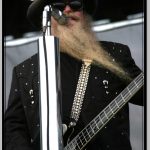King’s X is an American progressive metal band notorious for their spiritual lyrics and sophisticated music.
The group has its beginnings in 1980, when Doug Pinnick and Jerry Gaskill, who had met before on recording and touring with Phil Keaggy and toured with the Christian rock band Petra, recruited Ty Tabor to join them. Calling themselves The Edge, the group performed extensively on the Springfield, Missouri bar and club circuit. The band specialized in doing Top 40 covers. By 1983, the band’s name had changed to Sneak Preview and they began recording original material. Sneak Preview released the self-titled LP in 1984 with only original material.
The group moved to Houston, Texas with the promise of a recording contract, but the deal fell through. However, it was there that the group met Sam Taylor, then the vice president of ZZ Top‘s production company. Taylor quickly became the band’s mentor and convinced them to change their name to King’s X. Taylor was the instrument that helped the band secure a contract with Megaforce Records in 1987. Taylor would soon become the band’s manager, producer and mentor, and was declared the fourth member of the group.
The group released their first album as King’s X, titled “Out of the Silent Planet“, in 1988. Despite being well-treated by critics, the album did not do well commercially, peaking at number 144 on the album chart from Billboard. The band’s 1989 release, “Gretchen Goes to Nebraska” did slightly better from a commercial standpoint. Significantly, the video clip “Over My Head” received moderate support from MTV and radio. The increased exposure proved beneficial when the band released their third album “Faith, Hope, Love” in the fall of 1990.
Faith, Hope, Love was the band’s first album to reach the US Top 100, with the help of the hit single “It’s Love“. The band opened for AC/DC on a US and European tour during the first half of 1991. They also toured with Living Color at the peak of their popularity. The band signed with Atlantic Records for their next release.
The band released their fourth album, “King’s X“, in the spring of 1992. But tensions that surfaced with Taylor led to it being the group’s most unfocused effort, and the album didn’t sell as well as “Faith, Hope, Love“. The single from the album – “Black Flag” received only moderate support from MTV. Shortly after the release of King’s X, the band got rid of Taylor. Details of the separation have not been made public, but it is believed that there was a strong fight. Then King’s X took about a year to consider their collective future. The band members pursued other non-musical purposes, notably guitarist Ty Tabor doing semi-professional motorcycling.
In any case, by 1992 grunge was at its peak, and the band’s signature sound didn’t quite match that of commercially successful acts like Soundgarden or Pearl Jam (even though, ironically, King’s X was largely responsible for inspiring grunge, Pearl Jam bassist Jeff Ament once said: “King’s X invented grunge“). Looking for a new sound and flavor (though not necessarily grunge), the band enlisted producer Brendan O’Brien, who had recently produced the first album for Stone Temple Pilots and the second for Pearl Jam.
The album that resulted, 1994’s “Dogman“, featured a much more muscular and heavier sound from the group, along with less abstract and spiritual lyrics. The album received a major promotional push from Atlantic and the band enjoyed a very successful tour, with an appearance at the Woodstock 94 festival in August. But despite the group’s Top 100 return, the album did not achieve the sales Atlantic hoped for, and the label’s support for the band quickly faded.
The band’s third release with Atlantic, 1996’s “Ear Candy“, would also be their last (not including a subsequent compilation) with the label. Although it sold well to the band’s fans, it lacked the mainstream success of previous efforts. The album was soon unavailable, and it seemed that the group’s opportunity for commercial success had come and gone.
The group switched to Metal Blade Records in 1998. Their first album for that label, “Tape Head“, signaled a new era for the band. They modified their creative methods by writing and recording the album together in the studio, rather than coming together to record songs that the band members had written individually. The next two albums, “Please Come Home … Mr. Bulbous” and “Manic Moonlight” were created in this same way.
For their next album, “Black Like Sunday“, the group arranged and recorded an album filled with songs that the band had performed regularly before releasing their first album for MegaForce Records, “Out of the Silent Planet“.
“Live All Over The Place” was the band’s final album for Metal Blade Records, and their first official live release. In the period with Metal Blade, the members of King’s X (as a group and individually) were musically prolific, releasing a number of solo albums (such as Doug Pinnick’s PoundHound and Emotional Animal albums, Naomi’s Solar Pumpkin, Moonflower Lane, and Safety by Ty Tabor, and Jerry Gaskill’s musically intriguing Come Somewhere), and side projects (such as Ty Tabor’s work with Platypus, Jughead, and The Jelly Jam). Doug Pinnick replaced Living Color lead vocalist Corey Glover on the European tour of August 2006.
The band’s last album, titled “Ogre Tones“, was released in September 2005 through the InsideOut Music label. It was produced by famous rock producer Michael Wagener (Dokken, Extreme, Stryper, White Lion, Skid Row) at WireWorld Studio.
King’s X has struggled in the past with being identified as a Christian rock band. Many of their lyrics have a clear message of influence, but it comes from the individual faith of the members, and not from an attempt to enter the market in the way that groups like Stryper did. Their albums used to be heavily marketed in Christian bookstores, but after Pinnick announced in 1998 that he was gay, the albums were removed from Christian places. This also caused the band to lose a large number of its Christian fans.
Ty Tabor has indicated in several interviews that King’s X was not a Christian rock band. King’s X’s spiritual lyrics are less prominent on their latest releases, despite the band continuing to use spiritual themes in their music.
I took pictures of King’s X on October 29, 2004 at Starlite ROom in Edmonton, Alberta, Canada:































